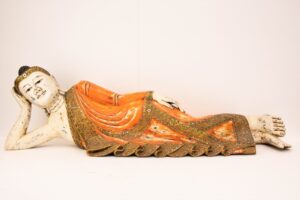I just returned from a three-week stay at my old monastery (greatvow.org). Overall, it all unfolded beautifully: my ‘best’ retreat in 25 years (long story). One crucial discovery stands out. Early on in the 9-day intensive retreat portion my lower back began to hurt severely: I couldn’t sit upright for any length of time. Switching to a chair with a backrest or using cushions as support didn’t help at all.
Now don’t get me wrong — as a long-time meditator with a history of physical pain I can attest that “our pain and our suffering are truly our path, our teacher. While this understanding doesn’t necessarily entail liking our pain or our suffering, it does liberate us from regarding them as enemies we have to conquer. Once we have this understanding, which is a fundamental change in how we relate to life, we can begin to deal with the layers of pain and suffering that make up so much of our existence.” [1]
I quickly decided to find a posture that would reduce back pressure and free me to investigate the “pain and suffering” phenomenon described above. Careful not to disturb ‘noble silence’ of the retreat setting — with fifty people meditating for seven hours spread over a long day — he gestured to the head monk for permission to use meditation mats to lie on the floor at the back of the hall.
♥
You’ve probably seen Buddha-like figures in a lying posture. It is said that 2600 years ago Siddhartha Gautama (known as the Buddha) taught his first disciples that “whether standing, walking, seated /or lying down, as long as she is awake, / she should develop this mindfulness.” [2]

Lying-so just enabled me to stay alert and at ease over many hours of meditating: body stretched as straight as possible / head supported by a firm cushion instead of resting on an elbow / legs straight with a natural bend at the knees / a small cushion placed between the knees / left hand resting next to my face / right hand on top with the hand aligned with the hips. NB: lying on my back tended to make me drowsy but worked for short periods; keeping the eyes open prevented drowsiness.
You or others may find this posture helpful as well. I’m thinking of feeling fragile, while recovering from surgery, or living with chronic discomfort. Meditation does not have to be done while sitting with legs crossed or upright in a chair. If needed, sitting up in bed, on a firm surface such as couch or floor, propped up with cushions or or against the wall; experiment the best way to be reasonably comfortable, upright, and alert. Alert: there is no meditation monster that’ll appear to chastise for doing this ‘wrong’. Click here for a short video on different ways to sit.
Infants seem to know how to meditate quite naturally —

[1] Ezra Bayda. “Pain without suffering“. Tricycle: The Buddhist Review. Winter 2002.Italics added. [2] From the Metta Sutta, verse 9, in the Pāli Canon, the standard collection of scriptures in the Theravada Buddhist tradition. Translated by the Nalanda Institute. I’ve substituted the traditional “he” with “she” and added the bolding.

Thanks for this, Peter! good information. All the best to you.